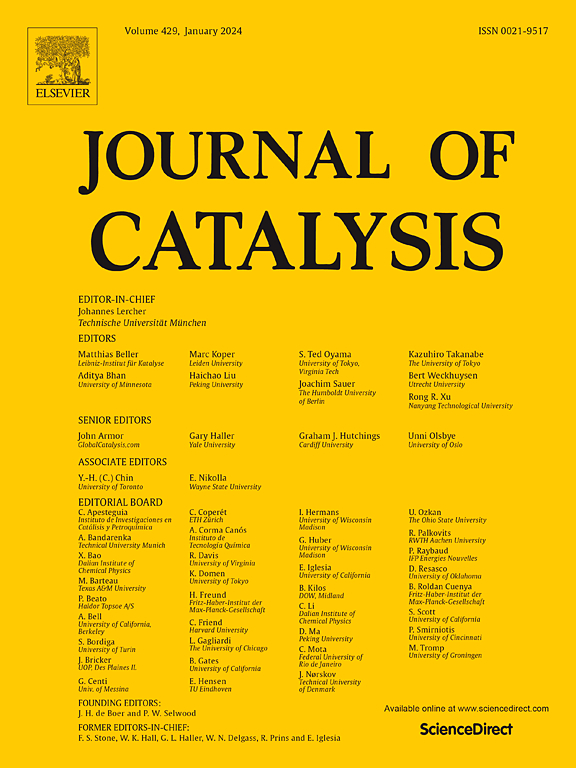Role of oxygen vacancies employing GaxZr1-xO2-y / ZrO2 in isobutene generation from ethanol
IF 6.5
1区 化学
Q2 CHEMISTRY, PHYSICAL
引用次数: 0
Abstract
This study advances the understanding of oxygen vacancies (Vo) in heterogeneous catalysis, focusing on isobutene synthesis from ethanol. Ga-doped ZrO2 was investigated and compared with Zn-doped ZrO2. Characterization techniques, including EPR, XRD, XPS, H2O dissociation, and Raman spectroscopy, revealed that Ga substitutes Zr in the m-ZrO2 lattice, generating more Vo than Zn. DFT calculations supported these findings, showing that incorporating two Ga atoms into monoclinic ZrO2 leads to spontaneous defect formation, with energies more negative than those for Zn-doped ZrO2. The isobutene synthesis from ethanol involves three steps: the acetaldehyde generation from ethanol, acetone synthesis from this aldehyde, and isobutene formation from acetone, the rate-limiting step (rls). Catalytic tests and CO2-TPD showed that the Lewis basicity of the ZrO2-based catalysts is not relevant for the isobutene formation. Experiments with Ga-doped t-ZrO2 (tetragonal) highlighted the relevance of ZrO2′s structure in the isobutene synthesis. It was observed that Ga-doped catalysts generate much more isobutene from acetone when compared with Zn-based catalysts. Moreover, the isobutene yield shows a linear correlation with Ga at. %, and consequently, with the Vo concentration. The superior performance of Ga-doped ZrO2 compared to Zn-doped ZrO2 might be attributed not only to Ga’s greater ability to generate Vo but also to the formation of a Ga(2)-Vo atomic ensemble, proposed by the DFT studies, which likely participates in the rls of this synthesis. This study offers new insights into the role of Vo in catalytic processes, providing perspectives for improving isobutene synthesis from ethanol and advancing the design of Vo-rich catalysts.

GaxZr1-xO2-y / ZrO2氧空位在乙醇生成异丁烯中的作用
本研究促进了对氧空位(Vo)在多相催化中的理解,重点是乙醇合成异丁烯。研究了ga掺杂ZrO2,并与zn掺杂ZrO2进行了比较。表征技术包括EPR、XRD、XPS、H2O解离和拉曼光谱,发现Ga在m-ZrO2晶格中取代了Zr,生成的Vo多于Zn。DFT计算支持了这些发现,表明将两个Ga原子掺入单斜ZrO2中会导致自发缺陷形成,其能量比掺杂zn的ZrO2更负。乙醇合成异丁烯包括三个步骤:乙醇生成乙醛,乙醛合成丙酮,丙酮生成异丁烯,这是限速步骤(rls)。催化实验和CO2-TPD结果表明,zro2基催化剂的Lewis碱度与异丁烯的生成无关。用ga掺杂t-ZrO2(四边形)的实验突出了ZrO2的结构在异丁烯合成中的相关性。结果表明,与锌基催化剂相比,掺ga催化剂从丙酮中生成的异丁烯更多。异丁烯产率与Ga值呈线性相关。%,因此与Vo浓度有关。与zn掺杂ZrO2相比,Ga掺杂ZrO2的优越性能可能不仅归因于Ga更强的生成Vo的能力,还归因于DFT研究提出的Ga(2)-Vo原子系综的形成,这可能参与了这种合成的过程。该研究对Vo在催化过程中的作用提供了新的认识,为改进乙醇合成异丁烯和推进富Vo催化剂的设计提供了新的视角。
本文章由计算机程序翻译,如有差异,请以英文原文为准。
求助全文
约1分钟内获得全文
求助全文
来源期刊

Journal of Catalysis
工程技术-工程:化工
CiteScore
12.30
自引率
5.50%
发文量
447
审稿时长
31 days
期刊介绍:
The Journal of Catalysis publishes scholarly articles on both heterogeneous and homogeneous catalysis, covering a wide range of chemical transformations. These include various types of catalysis, such as those mediated by photons, plasmons, and electrons. The focus of the studies is to understand the relationship between catalytic function and the underlying chemical properties of surfaces and metal complexes.
The articles in the journal offer innovative concepts and explore the synthesis and kinetics of inorganic solids and homogeneous complexes. Furthermore, they discuss spectroscopic techniques for characterizing catalysts, investigate the interaction of probes and reacting species with catalysts, and employ theoretical methods.
The research presented in the journal should have direct relevance to the field of catalytic processes, addressing either fundamental aspects or applications of catalysis.
 求助内容:
求助内容: 应助结果提醒方式:
应助结果提醒方式:


